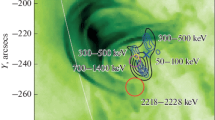Abstract
The magnetic field in the neutron-proton-electron (‘npe’) layer of a neutron star is caused by quasi-stationary vortex current of superconducting and normal protons relative to the normal electrons. The same current generates the radio emission due to the Josephson effect. The radiation propagates in the magnetically-active medium and goes out the crust through the cracks to the magnetosphere (‘npe’-layer is ‘optically thick’ layer). As a result the ‘hot radiospots’ on the star surface develop and a resulting polarized radiation pattern near the magnetic poles is formed. The cross-section of this radiation pattern gives the observed pulse structure of the pulsar. The variations of quasi-stationary vortex current can result in the amplitude-frequency variations of the radiation spectrum due to specific properties of the radiation mechanism. From this we have the variations of the fine spectrum structure, pulse amplitude and pulse structure and the correlation of them with the spectral index variations of pulsars in this model.
Similar content being viewed by others
References
Aslamasov, L. G. and Larkin, A. I.: 1969,Pis'ma v. JETP (USSR) 9, 150.
Baym, G., Pethick, C., and Pines, D.: 1969,Nature 224, 673, 674.
Baym, G. and Pethick, C.: 1975,Ann. Rev. Nucl. Sci. 25, 7.
De Gennes, P. G.: 1966,Superconductivity of Metals and Alloys, W. A. Benjamin, Inc., New York, Amsterdam.
Dyson, F.: 1971,Neutron Stars and Pulsars, Fermi Lectures 1970, Academia Nazionale dei Lincei, Roma.
Feynman, R. P., Leuton, R. B., and Sands, M.: 1963,The Feynman Lectures on Physics, vol. 3, Addison-Wesley Publ. Comp., London.
Ginzburg, V. L.: 1969,Uspekhi Phys. Nauk (USSR) 97, 601.
Ginzburg, V. L.: 1971,Uspekhi Phys. Nauk (USSR) 103, 393.
Haar, D. ter: 1972,Phys. Rep. 3c, No. 2.
Josephson, B. D.: 1962,Phys. Lett. 1, 251.
Kaner, E. A. and Scobov, V. G.: 1966,Uspekhi Phys. Nauk (USSR) 89, 367.
Kovalev, Yu. A.: 1974,II-d USSR Seminar on HF-devices, Erevan.
Kovalev, Yu. A.: 1976a, ‘IX-th Young European Radio Astronomers Conference’ (YERAC), Toruń, Poland.
Kovalev, Yu. A.: 1976b, ‘IX-th Conference on the Galactic and Extra-Galactic Radiostronomy’, Thesis of Reports, IRE AN Ukr. SSR Press, Kharkov, p. 64 and Preprint No. 326, Space Research Inst., Moscow (1977).
Kovalev, Yu. A.: 1978, XI-th YERAC (Abstracts), Jodrell Bank, England.
Kulik, I. O. and Yanson, I. K.: 1970,Josephson Effect in Superconducting Tunnel Structures, Izd. Nauka, Moscow (in Russian).
Sedrakian, D. M., Shahabassian, K. M., and Mücket, J.: 1974,Astrophysica (USSR)10, 257.
Steele, M. C. and Vural, B.: 1973,Wave Interactions in Solid State Plasmas, McGraw-Hill Book Co., New York.
Chernobaj, V. A.: 1977,Astron. Circular (USSR) No. 966, 1.
Author information
Authors and Affiliations
Rights and permissions
About this article
Cite this article
Kovalev, Y.A. A possible radio emission mechanism for pulsars. Astrophys Space Sci 63, 3–17 (1979). https://doi.org/10.1007/BF00647743
Received:
Issue Date:
DOI: https://doi.org/10.1007/BF00647743



